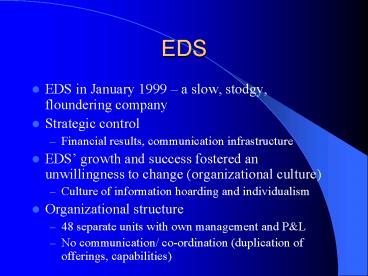EDS - PowerPoint PPT Presentation
1 / 19
Title:
EDS
Description:
EDS' growth and success fostered an unwillingness to change (organizational culture) ... No communication/ co-ordination (duplication of offerings, capabilities) ... – PowerPoint PPT presentation
Number of Views:69
Avg rating:3.0/5.0
Title: EDS
1
EDS
- EDS in January 1999 a slow, stodgy, floundering
company - Strategic control
- Financial results, communication infrastructure
- EDS growth and success fostered an unwillingness
to change (organizational culture) - Culture of information hoarding and individualism
- Organizational structure
- 48 separate units with own management and PL
- No communication/ co-ordination (duplication of
offerings, capabilities)
2
Organizational structure and control systems
- Session 19
3
Unfortunately, there may be no long-term
sustainable advantage other than the ability to
organize and manage.
- J. Galbraith E. Lawler
4
NYSE and NasdaqNonprofit to for-profit
institutions?
5
Organizational Design
- Organization Structure
- Planning and control systems
- Human resource management
- Culture and style
Source Collis Montgomery
6
Organizational Structure
- Control systems
- Co-ordination
- Motivation
- Differentiation
- Integration
- Bureaucratic costs
7
Differentiation
- Vertical
- Levels of hierarchy
- Principle of minimum chain of command
- Span of control
- Centralization v/s decentralization
8
Horizontal differentiation
- Based on
- Common tasks - Functional
- Products - Multidivisional
- National/ regional markets - Geographic
- Process
- Product-team
- Communities of practice
- Combination - Matrix
9
Project teams
TI Trying to superimpose and integrated process
on a fragmented organization
Source Hammer Stanton, 1999
10
Communities of practice
Source HBR 2000
11
Rationale for differentiation
- Economies of scale
- Economies of utilization
- Learning
- Standardization of control systems
Source Grant
12
Changing structures
- CompUSA re-organization
- Decentralized structure to regional sales
structure - Reduce duplication of sales and support staff
- Centralizing support functions
Source NYTimes, CompUSA website
13
Integration
- Co-ordination of activities
- Mechanisms
- Direct contact
- Liaison roles
- Task forces
- Teams
- Integrating roles
- Integrating departments
- Matrix structure
14
Strategic Control
- Building blocks of competitive advantage
- Balanced scorecard model
- Levels of control
- Types of control systems
15
Empowerment
Employees won't feel internally committed if
someone is always controlling them from the top
down.
Source Argyris 1998
16
Organizational culture
- Strategic leadership
- CEO/ Founder
- Top management team
- Mechanisms for transmission
- Adaptive v/s inert cultures
17
Organizational culture
In three different organizations, Sears, Shell
and the U.S. Army, the 800 pound gorilla that
impaired performance and stifled change
was culture
Source HBR, 1997
18
Reward systems
- Individual
- Piecework
- Commission systems
- Bonus plans
- Promotion
- Group
- Bonus systems
- Profit sharing
- Employee stock option plans
- Organization bonus
19
Balanced scorecards
- Link corporate goals to specific strategic and
operating targets - How do we look to shareholders?
- How do customers see us?
- What must we excel at?
- Can we continue to improve and create value?
Source Kaplan Norton































